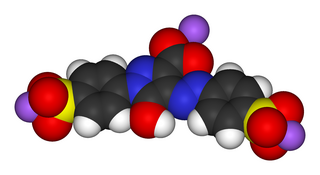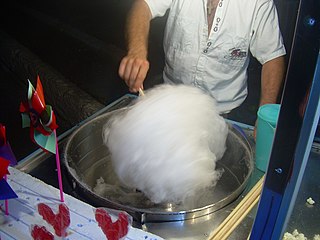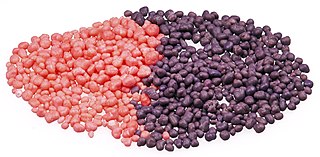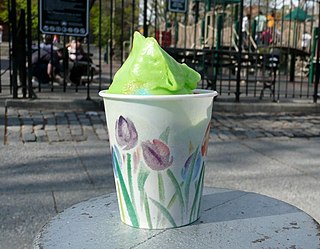
A flavoring, also known as flavor or flavorant, is a food additive used to improve the taste or smell of food. It changes the perceptual impression of food as determined primarily by the chemoreceptors of the gustatory and olfactory systems. Along with additives, other components like sugars determine the taste of food.

Food additives are substances added to food to preserve flavor or enhance taste, appearance, or other sensory qualities. Some additives have been used for centuries as part of an effort to preserve food, for example vinegar (pickling), salt (salting), smoke (smoking), sugar (crystallization), etc. This allows for longer-lasting foods such as bacon, sweets or wines. With the advent of ultra-processed foods in the second half of the twentieth century, many additives have been introduced, of both natural and artificial origin. Food additives also include substances that may be introduced to food indirectly in the manufacturing process, through packaging, or during storage or transport.

Grenadine is a commonly used nonalcoholic bar syrup characterized by its deep red color. It is a popular cocktail ingredient renowned for its flavor as well as its ability to give a reddish or pink tint to mixed drinks. Grenadine was traditionally made from pomegranate but is more often encountered as a syrup made from elder, blackcurrant, raspberry, gooseberry or other berries and fruits.

Food coloring, or color additive, is any dye, pigment, or substance that imparts color when it is added to food or drink. They can be supplied as liquids, powders, gels, or pastes. Food coloring is used in both commercial food production and domestic cooking. Food colorants are also used in a variety of non-food applications, including cosmetics, pharmaceuticals, home craft projects, and medical devices. Colorings may be natural or artificial/synthetic.

Annatto is an orange-red condiment and food coloring derived from the seeds of the achiote tree, native to tropical parts of the Americas. It is often used to impart a red or orange color to foods, but sometimes also for its flavor and aroma. Its scent is described as "slightly peppery with a hint of nutmeg" and flavor as "slightly nutty, sweet and peppery".

Gummy bears are small, fruit gum candies, similar to a jelly baby in some English-speaking countries. The candy is roughly 2 cm (0.8 in) long and shaped in the form of a bear. The gummy bear is one of many gummies, popular gelatin-based candies sold in a variety of shapes and colors.

Tartrazine is a synthetic lemon yellow azo dye primarily used as a food coloring. It is also known as E number E102, C.I. 19140, FD&C Yellow 5, Yellow 5 Lake, Acid Yellow 23, Food Yellow 4, and trisodium 1-(4-sulfonatophenyl)-4-(4-sulfonatophenylazo)-5-pyrazolone-3-carboxylate.

Cotton candy, also known as candy floss (candyfloss) and fairy floss, is a spun sugar confection that resembles cotton. It usually contains small amounts of flavoring or food coloring.

Processed cheese is a product made from cheese mixed with an emulsifying agent. Additional ingredients, such as vegetable oils, unfermented dairy ingredients, salt, food coloring, or sugar may be included. As a result, many flavors, colors, and textures of processed cheese exist. Processed cheese typically contains around 50 to 60% cheese and 40 to 50% other ingredients.

Vanilla extract is a solution made by macerating and percolating vanilla pods in a solution of ethanol and water. It is considered an essential ingredient in many Western desserts, especially baked goods like cakes, cookies, brownies, and cupcakes, as well as custards, ice creams, and puddings. Although its primary flavor compound is vanillin, pure vanilla extract contains several hundred additional flavor compounds, which are responsible for its complex, deep flavor. By contrast, artificial vanilla flavor is solely made up of artificially derived vanillin, which is frequently made from a by-product of the wood pulp industry. Because of the way that vanilla extract is made, there is no possible way for it to be colorless or clear. Therefore, any clear vanilla flavoring is artificial.

Nerds is an American candy launched in 1983 by the Sunmark Corporation under the brand name Willy Wonka Candy Company. Nerds are now made by the Ferrara Candy Company, a subsidiary of Ferrero Group. but is still distributed internationally by Nestlé. With their anthropomorphic covers, Nerds usually contain two flavors per box, each flavor having a separate compartment and opening.
Laffy Taffy is an American brand of taffy candies produced by the Ferrara Candy Company, a subsidiary of Ferrero. The candies are small, individually wrapped taffy rectangles available in a variety of colors and fruit flavors, including banana, strawberry, green apple, grape, blueberry, watermelon, blue raspberry, and cherry. Rarer flavors include caramel apple, coconut, strawberries & cream, apple crisp, chocolate mousse, pumpkin donut, pineapple, guava, orange sorbet, and lemon raspberry. Discontinued flavors include fruit punch, mango, strawberry banana, peppermint, and hot cocoa.

Italian ice is a semi-frozen sweetened treat composed of finely granulated ice and fruit concentrates, juices, or purées, or other natural or artificial food flavorings. Italian ice is similar to sorbet and snow cones, but differs from American-style sherbet in that it does not contain dairy or egg ingredients. The ingredients in Italian ice are mixed, then whipped during the freezing process similar to the process for making ice cream. As a group, Italian ice comes in a variety of consistencies from crunchy, to smooth, to slushy. In Philadelphia and the Delaware Valley, including South Jersey and northern Delaware, Italian ice is known as water ice.

Brilliant blue FCF is a synthetic organic compound used primarily as a blue colorant for processed foods, medications, dietary supplements, and cosmetics. It is classified as a triarylmethane dye and is known under various names, such as FD&C Blue No. 1 or acid blue 9. It is denoted by E number E133 and has a color index of 42090. It has the appearance of a blue powder and is soluble in water and glycerol, with a maximum absorption at about 628 nanometers. It is one of the oldest FDA-approved color additives and is generally considered nontoxic and safe.

Natural food and all-natural food are terms in food labeling and marketing with several definitions, often implying foods that are not manufactured by processing. In some countries like the United Kingdom, the term "natural" is defined and regulated; in others, such as the United States, the term natural is not enforced for food labels, although there is USDA regulation of organic labeling.
Drink mixers are the non-alcoholic ingredients in mixed drinks and cocktails. Mixers dilute the drink, lowering the alcohol by volume in the drink. They change, enhance, or add new flavors to a drink. They may make the drink sweeter, more sour, or more savory. Some mixers change the texture or consistency of the drink, making it thicker or more watery. Drink mixers may also be used strictly for decorative purposes by changing the color or appearance of the drink. They also simply increase the volume of a drink, to make it last longer.

Popcorn seasoning is any ingredient used to add flavor to popcorn. In the United States, popcorn seasoning is mass-produced by several companies for commercial and consumer use. Popcorn seasonings may be used to enhance the flavor of popcorn, and some are used to add a buttery flavor to popcorn. Significant amounts are often used to ensure the adequate flavoring of popcorn, due to popcorn's low density. It is also sometimes utilized to add coloring to popcorn. Some popcorn seasoning may contain monosodium glutamate. Some specialty products exist in unique flavors, such as chocolate and bubble gum. Some popcorn seasoning products may be referred to as popcorn salt.

Sherbet, often referred to as sherbert, is a frozen dessert made from water, sugar, a dairy product such as cream or milk, and a flavoring – typically fruit juice or purée, wine, liqueur, and occasionally non-fruit flavors such as vanilla, chocolate, or peppermint. It is similar to, but distinct from sorbet, which lacks dairy.
















